Publisher: Amy Marson Creative Director: Gailen Runge Editor: Lynn Koolish Technical Editor: Susan Nelsen Cover/Book Designer: April Mostek Production Coordinator: Joe Edge Production Editor: Jennifer Warren Illustrator: Valyrie Gillum Photo Assistants: Carly Jean Marin and Mai Yong Vang Instructional photography by Diane Pedersen of C&T Publishing, Inc., unless otherwise noted Published by C&T Publishing, Inc., P.O. Box 1456, Lafayette, CA 94549 DEDICATION To Cindy Barfield, my faithful assistant and friend. Thank you for everything you do for me.To Sandy Chapin, for inspiring me.Thanks to my sewing buddy, Jody, for taking the time to make Artful Log Cabins with me.To my editor, Lynn Koolish, for her keen eye and excellent words.To my husband, for his infinite patience about everything!And to my California familyRandalyn, Holly, and Terrie. I love you all so much! TRADITIONAL LOG CABIN QUILTS I love Log Cabin quilts, and I have been making them for more than 30 years. I enjoy the way the lights and darks play off each other and the hundreds of different patterns that can be created when all the blocks are put together. The traditional Log Cabin block usually has a red center square to symbolize the fire in the hearth and the warmth of a log cabin home.
TRADITIONAL LOG CABIN QUILTS I love Log Cabin quilts, and I have been making them for more than 30 years. I enjoy the way the lights and darks play off each other and the hundreds of different patterns that can be created when all the blocks are put together. The traditional Log Cabin block usually has a red center square to symbolize the fire in the hearth and the warmth of a log cabin home.
The majority of the block is made up of strips of the same width in light and dark values.  Barn Raising (for Larry and Sheryl Pasquini) by Katie Pasquini Masopust, Holly Cunningham, and Terrie Pasquini Robertson; 100 100; 2014 Photo by Carolyn Wright Construction of the block starts with the center square. Strips are added in a clockwise manner, starting with two light strips on two adjacent sides of the center block. These light strips symbolize the sides of the cabin that are brightened by the sun.
Barn Raising (for Larry and Sheryl Pasquini) by Katie Pasquini Masopust, Holly Cunningham, and Terrie Pasquini Robertson; 100 100; 2014 Photo by Carolyn Wright Construction of the block starts with the center square. Strips are added in a clockwise manner, starting with two light strips on two adjacent sides of the center block. These light strips symbolize the sides of the cabin that are brightened by the sun. 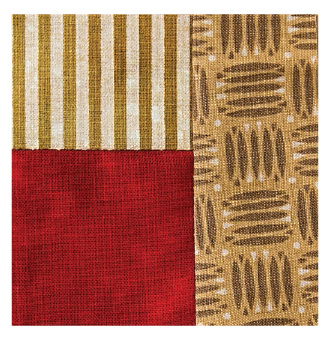 Red square with two light strips Next, two dark strips are added to the two remaining sides of the center block.
Red square with two light strips Next, two dark strips are added to the two remaining sides of the center block.  Two dark strips added This pattern is carried out until the block reaches its finished size.
Two dark strips added This pattern is carried out until the block reaches its finished size.  Two dark strips added This pattern is carried out until the block reaches its finished size.
Two dark strips added This pattern is carried out until the block reaches its finished size.
Generally, three strips per side will create the preferred patterns, but more strips can be added to make the block the desired size. 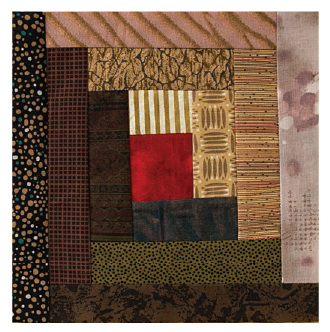 Completed block making traditional log cabin quilts
Completed block making traditional log cabin quilts  The Twisted Scissor Sisters Log Cabin Quilters 2015 Patriotic Sew-a-Thon Photo by Sarah Chapman and Katie Pasquini Masopust My sisters and I get together at least twice a year to make Log Cabin quilts. During one of these visits, we make bed-size traditional Log Cabins for ourselves or loved ones. In May, over the long Memorial Day weekend, we make red, white, and blue patriotic quilts to honor our veterans and to thank them for all that they do for us. We donate our quilts to the veterans program at College of the Redwoods in Humboldt County, California, where one of my sisters works.
The Twisted Scissor Sisters Log Cabin Quilters 2015 Patriotic Sew-a-Thon Photo by Sarah Chapman and Katie Pasquini Masopust My sisters and I get together at least twice a year to make Log Cabin quilts. During one of these visits, we make bed-size traditional Log Cabins for ourselves or loved ones. In May, over the long Memorial Day weekend, we make red, white, and blue patriotic quilts to honor our veterans and to thank them for all that they do for us. We donate our quilts to the veterans program at College of the Redwoods in Humboldt County, California, where one of my sisters works.  Circular Log Cabin by Katie Pasquini Masopust, 98 97, 2011
Circular Log Cabin by Katie Pasquini Masopust, 98 97, 2011  Custom Log Cabin by Katie Pasquini Masopust, 100 97, 2009
Custom Log Cabin by Katie Pasquini Masopust, 100 97, 2009  Barn Raising with Accents (for Randalyn Perkins) by Katie Pasquini Masopust, 98 98, 2013
Barn Raising with Accents (for Randalyn Perkins) by Katie Pasquini Masopust, 98 98, 2013 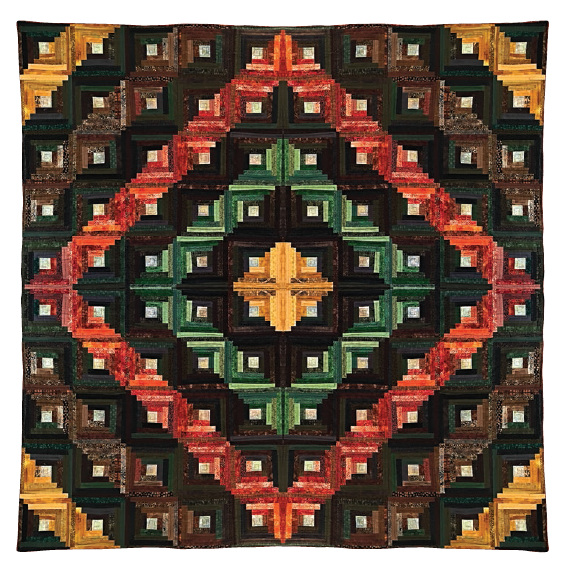 Marks Quilt by Katie Pasquini Masopust, Holly Cunningham, and Terrie Pasquini Robertson; 100 100; 2016 Photo by Katie Pasquini Masopust ARTFUL LOG CABIN QUILTS I teach my designs and techniques throughout the world.
Marks Quilt by Katie Pasquini Masopust, Holly Cunningham, and Terrie Pasquini Robertson; 100 100; 2016 Photo by Katie Pasquini Masopust ARTFUL LOG CABIN QUILTS I teach my designs and techniques throughout the world.  Circular Log Cabin by Katie Pasquini Masopust, 98 97, 2011
Circular Log Cabin by Katie Pasquini Masopust, 98 97, 2011  Custom Log Cabin by Katie Pasquini Masopust, 100 97, 2009
Custom Log Cabin by Katie Pasquini Masopust, 100 97, 2009  Barn Raising with Accents (for Randalyn Perkins) by Katie Pasquini Masopust, 98 98, 2013
Barn Raising with Accents (for Randalyn Perkins) by Katie Pasquini Masopust, 98 98, 2013  Marks Quilt by Katie Pasquini Masopust, Holly Cunningham, and Terrie Pasquini Robertson; 100 100; 2016 Photo by Katie Pasquini Masopust ARTFUL LOG CABIN QUILTS I teach my designs and techniques throughout the world.
Marks Quilt by Katie Pasquini Masopust, Holly Cunningham, and Terrie Pasquini Robertson; 100 100; 2016 Photo by Katie Pasquini Masopust ARTFUL LOG CABIN QUILTS I teach my designs and techniques throughout the world.
Periodically I have to create new classes so I can keep returning to my favorite venues. During one of these times, I realized that I love making Log Cabin quilts but had never taught them. If I was going to teach Log Cabin quilts, I had to put a new spin on this traditional design. What if I made it more abstract? I could add different types of grids to the traditional perpendicular grid. Beautiful places and objects are such an inspiration to mecould I use photographs to inspire the colors and values for the Log Cabin? Now I had the beginning of a great new class! The new grids would be placed over a photograph, and each block would be made up of the colors and the values seen in that portion of the photo. All forms would be reduced to lines of color (the lines being the strips of fabric making up the Log Cabin), creating a strong abstract design.
My new class became Artful Log Cabins, and I am now sharing it with you. I hope you enjoy it as much as I do! Happy Creating!  Straight Furrows Log Cabin (for Bobby Masopust Jr.) by Katie Pasquini Masopust, 56 104, 2014 Photos by Carolyn Wright
Straight Furrows Log Cabin (for Bobby Masopust Jr.) by Katie Pasquini Masopust, 56 104, 2014 Photos by Carolyn Wright  The first step in creating an Artful Log Cabin is to choose an inspiration. Most often this is a photograph, but some may choose to use a painting. The inspirational photograph or painting can be of any subject matter that excites you. Keep in mind that the quilt will not look exactly like the image; instead, it will be inspired by the colors and composition of the photograph or painting for a more abstract Log Cabin quilt. COMPOSITION The inspirational image should have a good compositionthat is, the way the objects or colors are arranged within the frame.
The first step in creating an Artful Log Cabin is to choose an inspiration. Most often this is a photograph, but some may choose to use a painting. The inspirational photograph or painting can be of any subject matter that excites you. Keep in mind that the quilt will not look exactly like the image; instead, it will be inspired by the colors and composition of the photograph or painting for a more abstract Log Cabin quilt. COMPOSITION The inspirational image should have a good compositionthat is, the way the objects or colors are arranged within the frame.
Next page
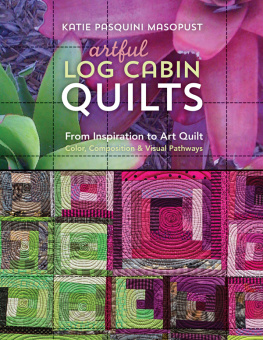
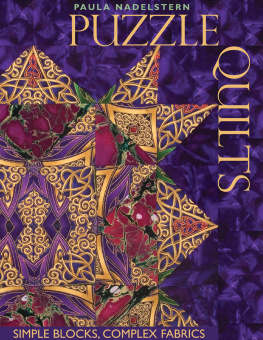
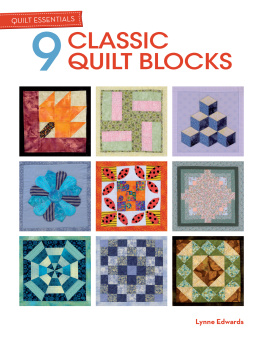

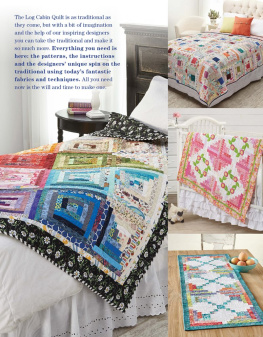
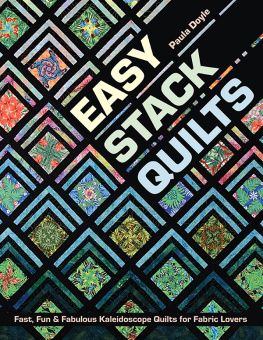
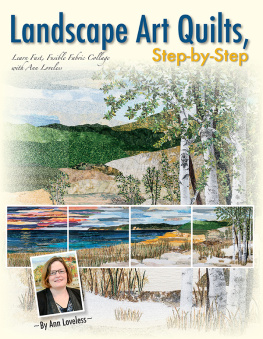
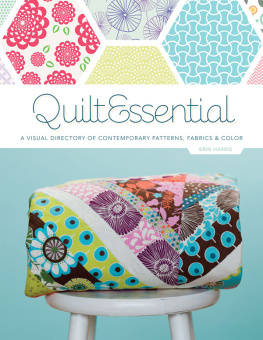
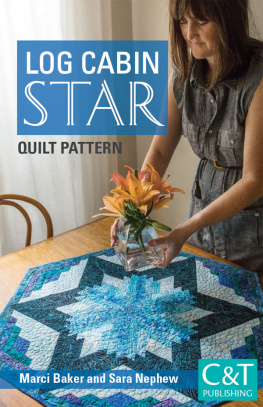
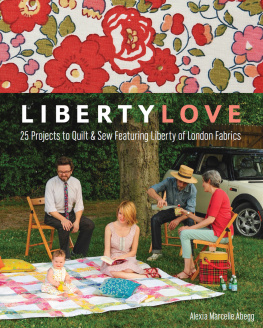

 TRADITIONAL LOG CABIN QUILTS I love Log Cabin quilts, and I have been making them for more than 30 years. I enjoy the way the lights and darks play off each other and the hundreds of different patterns that can be created when all the blocks are put together. The traditional Log Cabin block usually has a red center square to symbolize the fire in the hearth and the warmth of a log cabin home.
TRADITIONAL LOG CABIN QUILTS I love Log Cabin quilts, and I have been making them for more than 30 years. I enjoy the way the lights and darks play off each other and the hundreds of different patterns that can be created when all the blocks are put together. The traditional Log Cabin block usually has a red center square to symbolize the fire in the hearth and the warmth of a log cabin home. Barn Raising (for Larry and Sheryl Pasquini) by Katie Pasquini Masopust, Holly Cunningham, and Terrie Pasquini Robertson; 100 100; 2014 Photo by Carolyn Wright Construction of the block starts with the center square. Strips are added in a clockwise manner, starting with two light strips on two adjacent sides of the center block. These light strips symbolize the sides of the cabin that are brightened by the sun.
Barn Raising (for Larry and Sheryl Pasquini) by Katie Pasquini Masopust, Holly Cunningham, and Terrie Pasquini Robertson; 100 100; 2014 Photo by Carolyn Wright Construction of the block starts with the center square. Strips are added in a clockwise manner, starting with two light strips on two adjacent sides of the center block. These light strips symbolize the sides of the cabin that are brightened by the sun.  Red square with two light strips Next, two dark strips are added to the two remaining sides of the center block.
Red square with two light strips Next, two dark strips are added to the two remaining sides of the center block.  Two dark strips added This pattern is carried out until the block reaches its finished size.
Two dark strips added This pattern is carried out until the block reaches its finished size.  Completed block making traditional log cabin quilts
Completed block making traditional log cabin quilts  The Twisted Scissor Sisters Log Cabin Quilters 2015 Patriotic Sew-a-Thon Photo by Sarah Chapman and Katie Pasquini Masopust My sisters and I get together at least twice a year to make Log Cabin quilts. During one of these visits, we make bed-size traditional Log Cabins for ourselves or loved ones. In May, over the long Memorial Day weekend, we make red, white, and blue patriotic quilts to honor our veterans and to thank them for all that they do for us. We donate our quilts to the veterans program at College of the Redwoods in Humboldt County, California, where one of my sisters works.
The Twisted Scissor Sisters Log Cabin Quilters 2015 Patriotic Sew-a-Thon Photo by Sarah Chapman and Katie Pasquini Masopust My sisters and I get together at least twice a year to make Log Cabin quilts. During one of these visits, we make bed-size traditional Log Cabins for ourselves or loved ones. In May, over the long Memorial Day weekend, we make red, white, and blue patriotic quilts to honor our veterans and to thank them for all that they do for us. We donate our quilts to the veterans program at College of the Redwoods in Humboldt County, California, where one of my sisters works.  Circular Log Cabin by Katie Pasquini Masopust, 98 97, 2011
Circular Log Cabin by Katie Pasquini Masopust, 98 97, 2011  Custom Log Cabin by Katie Pasquini Masopust, 100 97, 2009
Custom Log Cabin by Katie Pasquini Masopust, 100 97, 2009  Barn Raising with Accents (for Randalyn Perkins) by Katie Pasquini Masopust, 98 98, 2013
Barn Raising with Accents (for Randalyn Perkins) by Katie Pasquini Masopust, 98 98, 2013  Marks Quilt by Katie Pasquini Masopust, Holly Cunningham, and Terrie Pasquini Robertson; 100 100; 2016 Photo by Katie Pasquini Masopust ARTFUL LOG CABIN QUILTS I teach my designs and techniques throughout the world.
Marks Quilt by Katie Pasquini Masopust, Holly Cunningham, and Terrie Pasquini Robertson; 100 100; 2016 Photo by Katie Pasquini Masopust ARTFUL LOG CABIN QUILTS I teach my designs and techniques throughout the world.  Straight Furrows Log Cabin (for Bobby Masopust Jr.) by Katie Pasquini Masopust, 56 104, 2014 Photos by Carolyn Wright
Straight Furrows Log Cabin (for Bobby Masopust Jr.) by Katie Pasquini Masopust, 56 104, 2014 Photos by Carolyn Wright  The first step in creating an Artful Log Cabin is to choose an inspiration. Most often this is a photograph, but some may choose to use a painting. The inspirational photograph or painting can be of any subject matter that excites you. Keep in mind that the quilt will not look exactly like the image; instead, it will be inspired by the colors and composition of the photograph or painting for a more abstract Log Cabin quilt. COMPOSITION The inspirational image should have a good compositionthat is, the way the objects or colors are arranged within the frame.
The first step in creating an Artful Log Cabin is to choose an inspiration. Most often this is a photograph, but some may choose to use a painting. The inspirational photograph or painting can be of any subject matter that excites you. Keep in mind that the quilt will not look exactly like the image; instead, it will be inspired by the colors and composition of the photograph or painting for a more abstract Log Cabin quilt. COMPOSITION The inspirational image should have a good compositionthat is, the way the objects or colors are arranged within the frame.